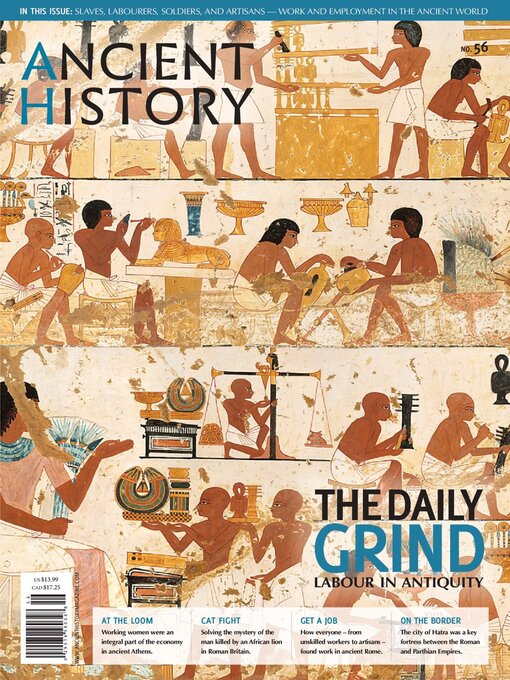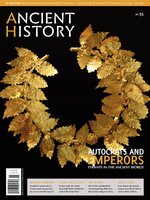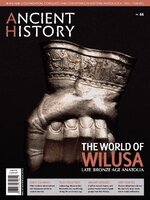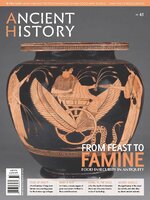Ancient History looks at every aspect of the ancient world: you'll find articles covering politics, society, literature, language, religion, economics, and art - all in one magazine! Like its big brother, Ancient Warfare, Ancient History Magazine is a bi-monthly, 60-page magazine that relies on a thematic approach: each issue is centered around one specific subject. From ancient Egyptian trade and Roman family life to the lost city of Pompeii, there's sure to be something for everyone - all presented in a well-researched but accessible, fun manner.
Ancient History Magazine
EDITORIAL – WORKING HARD, OR HARDLY WORKING
2600-year-old Etruscan tomb found intact
PRELIMINARIES
Roman baths became a Christian church
MANAGING AN EMPIRE • The Achaemenid Persian Empire (550–330 BC) far surpassed the reach of any predecessor. The Persian kings ruled from the coast of modern Turkey to the Eurasian steppe in Central Asia. But how exactly did the empire maintain control over its expansive realm? Royal representatives called ‘satraps’ managed the day-to-day operations of running the empire.
THE CITY OF HATRA • The once-splendid city of Hatra lies in the dry steppe of upper Mesopotamia in Iraq, some 300 km northwest of Baghdad. Enclosing an area of approximately 200 hectares, the city was encircled by 6-km-long walls and at its centre was an enormous temple complex to the Sun god Shamash. In the second century AD, Hatra found itself in the middle of a major geopolitical rivalry between the Roman and Parthian Empires.
A trading hub?
Rise of the Sasanians
TALKING TOOLS? • It is easy to overlook the fact that much, perhaps even most, of the art- and craftwork we appreciate today as the essence of Roman society was the result of the great effort and skill of enslaved labourers. Who were these individuals, and what was their contribution to the Roman economy? What ancient evidence is there to find out more about the work and labour of these marginalized, but far from marginal, persons?
The slave supply
Runaways and revolts
WARFARE AS A LIVELIHOOD • The revolutionary reforms of Philip II of Macedonia turned military service into a professional career. But it was in the chaotic aftermath of Alexander the Great’s sudden death that professional soldiering came fully into its own. From the disciplined Macedonian ranks to the mercenary markets of the Successors and Hellenistic kings, this article explores how the rise of paid, contract-based military service changed the nature of warfare in the Hellenistic age, when fighting was no longer a civic duty but a way to earn a living.
FINDING WORK • Discussions about labour in the Roman Empire tend to focus on the work of slaves. There were, of course, hundreds of thousands of slaves, if not more, at any one point in the Roman Empire. Yet freeborn people — both men and women — were also involved in labour, but their contributions are hard to discern.
Managing other workers
WOVEN WEALTH AND WOMEN’S WORK • Despite the iconi nude sculptures that survive in white marble, ancient Greeks wore clothes in a variety of colours and styles, and used textiles to furnish their homes, worship their gods, and power their warships. Who made them, by what methods and in what conditions, and how did this work shape the economy and culture of ancient Greece?
“AS LONG AS MY PEOPLE KEEP ON WORKING” • Egypt is famous for its towering pyramids and hypostyle halls, lasting monuments to human engineering. Less well known are the stories of those who built them, from the masons cutting stones for monumental tombs, to the carpenters measuring planks for sleek riverboats. Many ruling dynasties rose and fell as Egypt fractured and reunified, was conquered, and went through periods of decline. Throughout all this, everyday...

 AH 56
AH 56
 AH 55
AH 55
 AH 54
AH 54
 AH 53
AH 53
 AH 52
AH 52
 AH 51
AH 51
 AH 50
AH 50
 AH 49
AH 49
 AH 48
AH 48
 AH 47
AH 47
 AH 46
AH 46
 AH 45
AH 45
 AH 44
AH 44
 AH 43
AH 43
 AH 42
AH 42
 AH 41
AH 41
 AH 40
AH 40